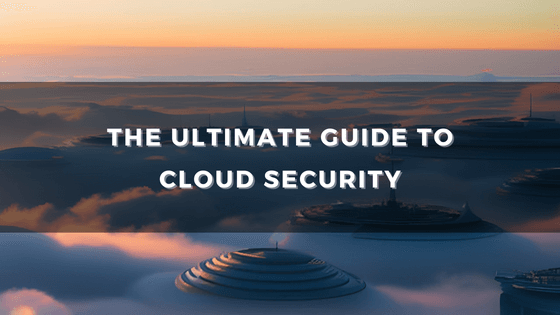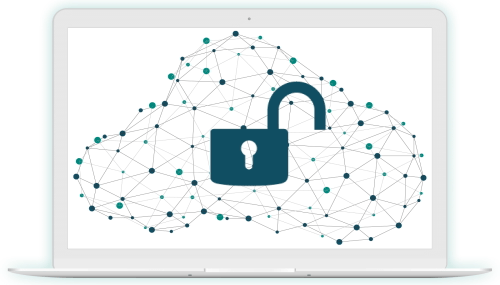Introduction to Cloud Security
In today's interconnected world, businesses and organizations are increasingly relying on cloud computing to store, process, and manage their data. While the cloud offers numerous benefits such as scalability, flexibility, and cost-efficiency, it also introduces unique security challenges. This is where cloud security comes into play.
Cloud security involves the implementation of strategies, practices, and technologies to protect data, applications, and infrastructure in cloud environments. It aims to safeguard sensitive information from unauthorized access, data breaches, data loss, and other potential threats.
One of the key considerations in cloud security is understanding the shared responsibility model. Cloud service providers (CSPs) are responsible for securing the underlying cloud infrastructure, such as the physical data centers, network, and hypervisors. However, the responsibility for securing the data and applications that reside within the cloud falls on the customer or user.
Access restrictions, data encryption, network security, incident response, and disaster recovery are just a few of the many topics covered by cloud security. It necessitates a thorough strategy that integrates technology controls, rules, and personnel education.

In this blog post, we will explore the best practices for cloud security, the importance of internationally accredited certifications, and the free resources available to professionals looking to enhance their cloud security knowledge. Whether you're a cloud architect, administrator, or security professional, this guide will provide you with valuable insights and practical recommendations to help you navigate the complex landscape of cloud security.
Organizations can confidently use the power of the cloud while protecting the integrity, confidentiality, and availability of their data by putting in place efficient cloud security procedures. Let's explore the realm of cloud security and learn the vital techniques and credentials that will enable you to safeguard your cloud-based assets.
Best Practices for Cloud Security
53% of businesses reported a cloud attack in 2018, and the majority of those breaches resulted in unforeseen costs to close security flaws, based on Netwrix's 2022 Cloud Data Security study. So, it's very important for organizations to understand the best cloud security practices for 2023. Now, let's review cloud security best practices.
Categorize Your Cloud Locations and Service
Organizations are better able to analyze risks, implement appropriate security measures, comply with regulations, manage access efficiently, keep an eye out for incidents, and make wise vendor partnership selections when cloud locations and services are categorized. It aids businesses in developing an organized and personalized approach to cloud security, ensuring that the appropriate security controls are used with the appropriate cloud environments and services.
Categorizing cloud locations and services allows organizations to conduct:
- Risk Assessment
- Granular Security Controls
- Compliance and Regulatory Requirements
- Access Management and Authentication
- Monitoring and Incident Response
- Vendor Management
Understand the Shared Responsibility Model
In a private data center, the enterprise bears sole responsibility for addressing security concerns. However, the dynamics become significantly more intricate in the realm of public cloud environments. While the ultimate accountability rests with the cloud customer, cloud providers assume certain responsibilities for IT security. This collaborative arrangement is commonly known as the shared responsibility model, acknowledged by cloud and security professionals.
Prominent Infrastructure as a Service (IaaS) and Platform as a Service (PaaS) providers, such as Amazon Web Services (AWS) and Microsoft Azure, furnish comprehensive documentation to their customers, clarifying the specific areas of responsibility in different deployment scenarios. Consider the diagram below, which illustrates Microsoft's delineation of responsibilities: when employing Software as a Service (SaaS) models, application-level controls are the provider's purview, but in IaaS deployments, they shift to the customer. PaaS models, on the other hand, entail shared responsibilities between Microsoft and its customers.
Before committing to a specific cloud vendor, enterprises should diligently examine the vendor's policies concerning shared security responsibilities. Potential misunderstandings and misunderstandings about who is responsible for what components of cloud security can be avoided by having a full understanding of who is responsible for each. Furthermore, this accountability transparency becomes crucial in averting security mishaps caused by disregarded or neglected security needs.
Use Log Management and Continuous Monitoring
To ensure secure operations, your cloud infrastructure must be continuously monitored. Your chosen cloud services, industry, and particular business use cases will determine the specific monitoring tools you utilize. However, there are a number of suggestions that can help direct the approach.
Making the time to become a certified cloud security professionals is one of the ways you can aid to get ready for making such decisions. You will then have the groundwork necessary to approach any cloud environment with assurance and make sure that the appropriate cloud security best practices are implemented.
Practitioner Certificate in Cloud Security Training
CCSP Certified Cloud Security Professional Certification Preparation Training
Offensive Cloud Security Training
Utilize an Identity and Access Management Solution
Unauthorized access poses a significant threat to the security of public cloud environments. Cyber attackers are constantly refining their techniques to gain access to sensitive data, making it crucial for organizations to implement a robust identity and access management (IAM) solution as a defense against these threats.
To mitigate unauthorized access risks, security experts advise organizations to seek out an IAM solution that enables them to establish and enforce access policies based on the principles of least privilege and zero trust. These policies should leverage role-based access control (RBAC) permissions to grant appropriate levels of access to users. Additionally, incorporating multi-factor authentication (MFA) adds an extra layer of security by reducing the chances of malicious actors successfully infiltrating sensitive information. Even if hackers manage to steal usernames and passwords, the additional steps of biometric scans or authentication codes via text messages make it significantly more difficult for them to proceed.
Additionally organizations should consider an IAM solution that is compatible with hybrid environments, encompassing both private data centers and cloud deployments. This compatibility simplifies authentication for end users and enables security staff to consistently enforce access policies across all IT environments, ensuring a cohesive and comprehensive security approach.

Establish Data Encryption and Secure Storage
Data encryption involves converting your data into a coded form that can only be understood with a specific key. It's like translating your data into a secret language that can only be deciphered by someone who has the right key. By encrypting your data before storing it in the cloud, even if someone manages to access or intercept it, they won't be able to make sense of the information without the decryption key.
Here's why data encryption and secure storage are important for cloud security:
- Confidentiality
- Protection against Data Breaches
- Compliance with Regulations
- Data Integrit
- Secure Storage
You can further protect your sensitive data by encrypting it and storing it on the cloud in a secure manner. Without the encryption key, it assures that even if unauthorized individuals access your data, they won't be able to decipher it or use it inappropriately. This gives you piece of mind and lowers the possibility of data breaches or unauthorized access by maintaining the confidentiality, integrity, and compliance of your data.
Internationally Accredited Cloud Security Certifications
Security professionals can demonstrate their fundamental understanding of infosec topics by earning certifications. These certifications are recognized and respected within the industry, demonstrating your expertise and commitment to cloud security.
It's critical to select the certification that corresponds with your specific cloud platform or area of interest because each has a different focus and set of requirements.
Certified Cloud Security Professional (CCSP): Offered by (ISC)², the CCSP certification is designed for professionals with advanced skills in cloud security architecture, design, operations, and service orchestration. It covers topics such as cloud data security, cloud platform and infrastructure security, and legal and compliance issues. Having this certification helps you achieve the highest standard for cloud security expertise and enable your organization to benefit from the power of cloud computing while keeping sensitive data secure.
CCSP Certified Cloud Security Professional Certification Preparation Training
Offensive Cloud Security Course
AWS Certified Security - Specialty: This certification from Amazon Web Services (AWS) validates expertise in securing AWS cloud environments. It covers various security aspects, including identity and access management, data protection, incident response, and infrastructure security. It demonstrates proficiency in securing AWS workloads and implementing best practices.
Microsoft Certified Azure Security Engineer Associate: The Azure Security Engineer Associate certification focuses on securing Microsoft Azure cloud environments. It covers topics like identity and access management, network security, data protection, and threat protection. It validates skills in implementing security controls and responding to security incidents within Azure.
Training: Designing Microsoft Azure Infrastructure Solutions (AZ-305)
Microsoft Azure Training Catalogue
CompTIA Security+: While not specifically cloud-focused, the CompTIA Security+ certification is highly regarded in the cybersecurity field. It covers a wide range of security topics, including cloud security, network security, risk management, and cryptography. It provides a strong foundation in cybersecurity principles and best practices.
Three Key Benefits of Cloud Security Certifications for Professionals
- Enhanced Career Opportunities: Cloud security certifications demonstrate a high level of expertise and competency in securing cloud environments. These certifications can open up new career opportunities and increase your marketability in the industry. Employers often seek professionals with recognized certifications to handle critical cloud security roles, such as cloud security architects, security engineers, or consultants. Having these certifications on your resume can give you a competitive edge when pursuing career advancements or new job opportunities.
- Validation of Skills and Knowledge: Cloud security certifications validate your skills and knowledge in specific cloud platforms or security frameworks. They provide a standardized benchmark for evaluating your proficiency in cloud security practices, tools, and technologies. By earning a reputable certification, you showcase your commitment to staying current with industry best practices and your ability to implement robust security measures in cloud environments. This validation can enhance your professional credibility and instill confidence in employers, clients, and colleagues.
- Stay Updated with Evolving Cloud Security: Cloud security is a rapidly evolving field, with new threats, technologies, and compliance requirements emerging regularly. Cloud security certifications often require candidates to stay updated with the latest industry trends and advancements. Through the certification process, professionals gain access to relevant study materials, training resources, and communities of like-minded individuals. This ensures that certified professionals stay abreast of the evolving cloud security landscape, enabling them to apply the latest practices and strategies to protect cloud-based assets effectively.
In conclusion, cloud security certifications give professionals better employment options, confirm their abilities, and offer chances for ongoing education so they can keep up with changing cloud security procedures. In addition to fostering professional development, these certifications show a dedication to excellence in cloud environment security, which is becoming more and more important in today's technologically advanced world.
Free Cloud Security Resources
We value our customers with whom we have been organising training events for years, our newest customers living in different parts of the world, our regulars of our blog page, our social media followers and all of you who have become a part of the Bilginç IT Academy family! We are constantly working to provide you with world-class training and to ensure that you choose the right training for yourself or your team. For this reason, we also share with you free documents that you can benefit from before or during your training. You can access the books that are best-sellers all over the world, lesser-known treasure-worthy documents recommended by our trainers, YouTube videos we have prepared for you and our free online trainings from the links below.
Online Academy (Free online courses)
Free Documents (Free e-books that you can download)
If you’d like to explore our cloud security courses and certifications, we welcome you to do so! You can start here.